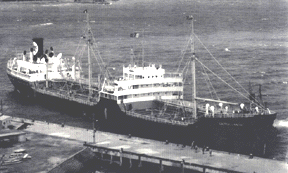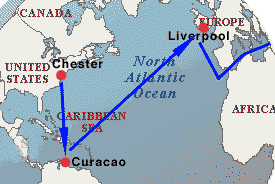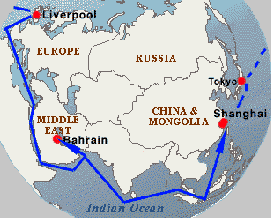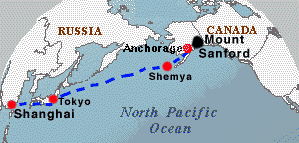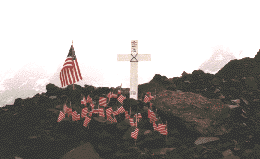Tragic Voyage of the SS Sunset Crew
by Bruce Felknor
On 19 December 1947, the three-year-old T-2 tanker SS Sunset slipped her moorings at Chester, Pennsylvania, and started on a three month voyage across eight of "the seven seas."
The officers were Scandinavians. The crew were Americans, one of whom, Wilfred Beswick, was a British native with dual citizenship. It was the last trip for all 24 crewmen, nearly all of them veterans of World War II, including 21-year-old Robert Delaney, who had two ships torpedoed out from under him.
SS Caltex Lisbon, former SS Sunset, 1953The Panamanian-flag Sunset, owned by the Caltex subsidiary, Overseas Tankship Corp., was bound for Curacao. There she loaded oil for Liverpool, via the Caribbean and North Atlantic.
The solid blue lines show the approximate route of SS SunsetOn 15 January, she sailed empty for Bahrain, via the Atlantic, Mediterranean, Suez Canal, Red Sea, Arabian Sea, and the Persian Gulf. The Sunset, pumped full of oil, left Bahrain for Shanghai via the Persian Gulf, Arabian Sea, Indian Ocean, South China Sea, and East China Sea. While at sea, the crew learned their ultimate destination would be Shanghai and they would be flown home from there.
The Sunset reached Shanghai on 11 March 1948, and the crew signed off immediately. Captain P. J. Barbe and the entire company of officers stayed with the ship.
The solid blue lines show the route of SS Sunset. The broken blue line shows the route of Flight 4422As they went ashore, a larger crew of Chinese seamen (at about a quarter of the wages of the Americans) boarded the tanker to pump her out and sail on. Tankermen were accustomed to little shore time since pumps worked faster than stevedores. So the 24 Americans were hardly surprised that their trip home would begin the same day, on Northwest Airlines charter Flight 4422.
Northwest DC-4
The DC-4 was destined for New York's LaGuardia Airport, with fuel stops at Tokyo, Shemya in the western Aleutians, Anchorage, Edmonton (Alberta), and Minneapolis. The fresh crew that took over at Anchorage and the original crew were veterans. The first three segments went perfectly. Flight 4422 disappeared one hour after leaving Anchorage.
The broken blue line shows the route of Flight 4422The Aurora Borealis was unusually bright that night, and investigators from the Civil Aeronautics Board (predecessor agency to the FAA) concluded in their accident report that the pilot "had been blinded by it while flying a course off the [established] airway."
Presumably, he was flying a well-known shortcut between two peaks in southeast Alaska's Wrangell Mountains when, blinded by the brilliant Aurora, he flew into a glacier on 16,237-ft Mount Sanford. At that moment, in a hamlet forty-five miles away a schoolgirl watching the display of northern lights saw a sudden flaring of light that is believed to mark the end of Flight 4422.
Two hours after the crash, a bush pilot who managed to start his plane in the 35-below (F) weather flew near the wreckage but could not find it. The next morning, he and a huge search and rescue operation located the wreckage but realized that if -- miraculously -- anyone had survived the crash, he could not have survived the frigid night.
The scattered remnants slid down the glacier from the 11,000-foot point of impact to about 8,000 feet, where snow and ice quickly covered them. Alaska's winter made it impossible to get to the site on the ground, thwarting efforts and plans by bush pilots, helicopters, and dog sled teams. Airborne clergy dropped funeral wreaths at the location. There was one more sighting that night, and then the snow and the churning glacier buried all evidence of a crash.
The crash was the worst in Alaskan history. After the rumors began, it became one of the most notorious. Some said the flight carried secret documents from World War II, others said diamonds. But in Alaska, where speculation about gold never seems far from the surface, most of the rumors centered on gold. The rumors sparked at least 20 expeditions to find the crash site and ferret out the gold.
But the tragedy of Flight 4422 stirred other efforts quite apart from the search for hidden treasure. There was the automatic CAB investigation, pointing to pilot error in unusual atmospheric conditions. A brief aerial memorial service was conducted over the site, six days after the crash.
The Search
There was a remarkable humanitarian effort which will be of special interest to merchant marine veterans, who are accustomed to being ignored or forgotten by media and public. It is a story of two airline pilots who spent their spare time and money over a decade to locate the crash, identify and honor the human remains, and bring closure to the families of the 24 dead mariners and the air crew of 6. The pilots are friends and fellow Air Force reservists, Kevin McGregor of Delta Airlines and Marc Millican of Northwest. Each learned that the other had been researching the 1948 crash during a chance meeting in 1994 in the officers club at Travis Air Force base.Marc Millican (left) and Kevin McGregor (right)
Separately, the two pilots heard the stories, and looked into the crash. McGregor started researching the human side of the story; in libraries and archives he looked up old new stories of the crash and found pictures of many of the seamen in local newspapers. He contacted families and began reconstructing the lives of the men.
Millican, who lives in Anchorage, focused on analyzing the plane's position and studying the area of the crash. He flew over the area, photographing it and studying the shape of the mountain and the glacier winding down its side. Their individual interests and approaches merged perfectly.
Millican owned a light, high-performance airplane, a Super Cub, made to order for bush flying in the most difficult conditions, and he knew the area. McGregor was a skilled mountaineer, experienced at climbing on ice in the Himalayas and on Mount Rainier.
They left the officers club at Travis AFB with a plan. They would fly to the mountain, land the light plane on a safe niche, and cover the area on foot searching for evidence of the missing DC-4. Their first trips, in 1994, 1995, and 1996, came to naught, but in July 1997, Millican found a new spot to land on the mountain.
At left: Marc Millican inspects engine [photo by Kevin McGregor]
The pair began their trek, scrambling up the ice and rock-littered terrain for ten hours under 70-pound packs. They slept in an expedition tent and next morning began a dangerous descent along the glacier, peering through rain and fog for evidence.
Millican spotted a twisted piece of aluminum on the ground, then a three-bladed propeller thrust upright from a mound of ice. McGregor found a radial engine, then a metal scrap with an engine serial number. The 1998 trip revealed more bits of evidence. The most unsettling discovery came in the summer of 1999: a human arm thrust upward from the glacier.
Initially their efforts were centered around solving the legend by finding the plane and finding answers to the rumors about gold. But as their research progressed, the fate of the 30 dead men and the grief of their families changed their objective: to bring closure to the families, who would now know exactly where their loved ones died.
Ring inscribed "Iran 1946" found at site. Can you identify the owner?For two years McGregor and Millican kept their findings secret, until they were able to positively identify the airplane by the engine serial number, contact as many as possible of the next of kin, secure National Parks permission to remove objects from the site, and establish a fitting memorial. With legal assistance, they were able to gain National Parks approval, and the two pilots completed the groundwork for a permanent exhibit in the Aviation Heritage Museum in Anchorage in February 2000.
Site of the crash on Mount Sanford, Alaska
Here are the names of the Sunset's ill-fated crew, listed with their home towns. They are memorialized at last through the extended efforts of Maj. Kevin McGregor (USAFR, retired) and Lt.-Col. Marc Millican (USAFR), to whom seafarers everywhere owe a vote of thanks.
Wilfred "Billy" Henry Beswick, Old Trafford, Manchester, England
Eugene J. Adler, Fall River, MA
Morris "Max" Brooks, Bronx, NY
John R. Comshick, West Hazleton, PA
Howard A. Davidson, Bayonne, NJ
Robert William" Billy" Delaney, Keyport, NJ
Arthur L. Eilertsen, New York, NY
John V. Elkins, Richmond, NY
Eugene O. Foote, Kaplan, LA
Olan J. Jacobsen, Brooklyn, NY
John "Jackie" Joseph Jamele, Brooklyn, NY
Everett W. Jenkins, Brazil, IN
August E. Koistinen, Toivola, WI
James G. Lampman, Jersey City, NJ
Michael Marushak, Sewaren, NJ
Travis M. McCall, Tifton, GA
James G. Mooney, Paterson, NJ
Edwin Mustra, Plainfield, NJ
Robert J. Rabich, Easton, PA
John W. Rapchinski, Bayonne, NJ
Daniel C. Rice, Milwaukee, WI.
Carl F. Sigmund, Poquonock Bridge, CT
Frank J. Van Zandt, Roanoke, VA
Stanley C. Wilkowski, Bayonne, NJ
The Northwest Airlines crew who died with them were:
Captain Robert Petry, pilot
Captain James Van Cleef, pilot
Jehu Stickel, co-pilot
Wayne Worsely, navigator
Donald Rector, flight mechanic
Robert Haslett, purserSources:
Maps adapted from Microsoft Encarta 98
SS Caltex Lisbon, photo by V.H. Young & L.A. Sawyer ship Photographers, Wellington NZ
Northwest DC-4 photo courtesy Northwest Airlines
"Flight 4422: The Legend and the Truth," Up Here, April 2000
Other photos courtesy Kevin McGregorBruce Felknor's Home Page
Home6/21/00
www.USMM.org ©1998 - 2000 Bruce Felknor and. You may quote small portions of material on this website as long as you cite American Merchant Marine at War, www.usmm.org, as the source. You may not use more than a few paragraphs without permission. If you see substantial portions of any page from this website on the Internet or in published material please notify usmm.org @ comcast.net
